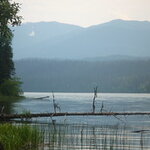Geology
Reports by scientists of meteorites striking Earth in the past have resembled police reports of so many muggings — the offenders came out of nowhere and then disappeared into the crowd, making it difficult to get more than very basic facts.
Now an international research team has been able to identify an asteroid in space before it entered Earth's atmosphere, enabling computers to determine its area of origin in the solar system as well as predict the arrival time and location on Earth of its shattered surviving parts.
"I would say that this work demonstrates, for the first time, the ability…

Nyiragongo, an active African volcano, possesses lava unlike any other in the world, which may point toward its source being a new mantle plume says a University of Rochester geochemist.
The lava composition indicates that a mantle plume—an upwelling of intense heat from near the core of the Earth—may be bubbling to life beneath the soil of the Democratic Republic of the Congo. The findings are presented in the current issue of the journal Chemical Geology.
"This is the most fluid lava anyone has seen in the world," says Asish Basu, professor of earth science at the University of Rochester…

The snow-laden region of Rupes Tenuis on the martian north pole got some images courtesy of ESA’s Mars Express orbiter. The images are centred around 81° north and 297° east and have a ground resolution of 41 m/pixel. They cover an area of about 44 000 km2, almost as large as the Netherlands.
Rupes Tenuis is located at the southern edge of the martian north polar cap, approximately 5500 km northeast of the Tharsis volcanic region.
At present, polar caps contain the largest water reservoir on the Red Planet. Recent data from the Mars Advanced Radar for Subsurface and Ionosphere Sounding (…

Planetary geologists at Brown University have found a gully fan system on Mars that formed about 1.25 million years ago. The fan offers compelling evidence that it was formed by melt water that originated in nearby snow and ice deposits and may stand as the most recent period when water flowed on the planet.
Gullies are known to be young surface features on Mars. But scientists studying the planet have struggled with locating gullies they can conclusively date. In a paper that appears on the cover of the March issue of Geology, the Brown geologists were able to date the gully system and…

Titan's vast dune fields, which may act like weather vanes to determine general wind direction on Saturn's biggest moon, have been mapped by scientists who compiled four years of radar data collected by the Cassini spacecraft.
Titan's rippled dunes are generally oriented east-west. Surprisingly, their orientation and characteristics indicate that near the surface, Titan's winds blow toward the east instead of toward the west. This means that Titan's surface winds blow opposite the direction suggested by previous global circulation models of Titan.
"At Titan there are very few…

Unique fractures in lavas on ancient Mars suggest water occasionally flooded portions of the planet's surface. The fractures, known as "columnar joints," are the first that have been observed on a planet other than Earth.
The characteristics of the column-like fractures can help scientists understand the role of water in geologic processes on Mars, said Moses Milazzo, a geophysicist with the U. S. Geological Survey Astrogeology Team in Flagstaff and lead author on a paper on the discovery recently published in the journal Geology.
"Columnar joints form as cooling lava contracts…

To reach the west side of the Bowron Lake paddling route, we must first face several kilometres portaging muddy trails to meet up with the Isaac River and then paddle rapids to grade two.
At the launch site, we meet up with two fellow kayakers, Adele and Mary of Victoria, and take advantage of their preceding us to watch the path they choose through the rapids. It has been raining in the area for forty plus days, so the water they run is high and fast. Hot on their heels, our short, thrilling ride along the Isaac River, is a flurry of paddle spray and playing around amid all the…

Ice in Antarctica suddenly appeared — suddenly in geologic terms being a little different than how we think of it — about 35 million years ago. For the previous 100 million years the continent had been essentially ice-free. Even after Antarctica had drifted to near its present location, its climate remained subtropical but then, 35.5 million years ago, ice formed on Antarctica in only about 100,000 years, which is an "overnight" shift in geological terms.
What triggered the sudden shift?
It wasn't global cooling, says Matthew Huber, assistant professor of earth and atmospheric…

The wind favours us now as we paddle the last of the Bowron Lake circuit. We'd rigged kayak sails on both the single and double kayaks and are excited to use them to add an extra knot of oomph to our efforts.
Reaching the golden land of safety-in-numbers, we leap from our kayaks, happy to see the smiling faces of Mary and Adele, the new friends we'd met before running the river earlier in the trip.
Making it here is doubly thrilling because it means I’m sleeping indoors tonight and I can tell the bear story with adrenaline still pumping through my veins. …

As we brace our way into a head wind along the east side of the fjord-like Isaac Lake, I soak up the view of this vast, deep green, ocean-like expanse that runs L-shape for nearly 38 kilometres, forming nearly half of the total circuit. The rock we paddle past is primarily calcareous phyllite, limestone and quartzite, typical of the type locality for this group and considered upper Proterozoic (Young, 1969), the time in our geologic history between the first algae and the first multicellular animals.It is striking how much this lake fits exactly how you might picture pristine…